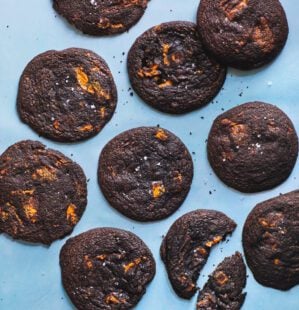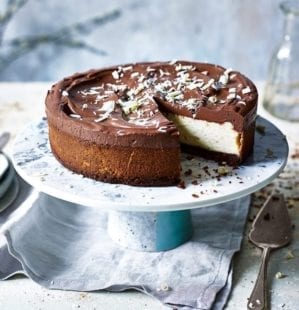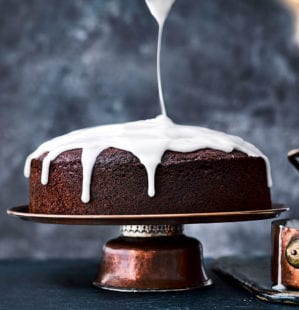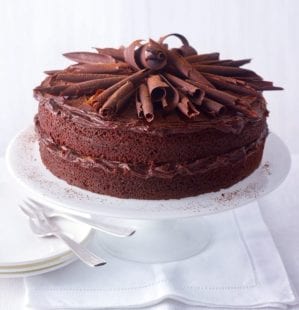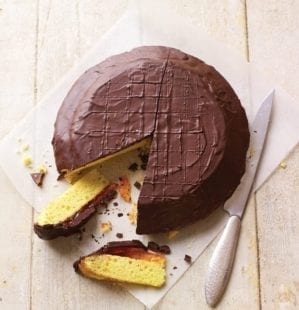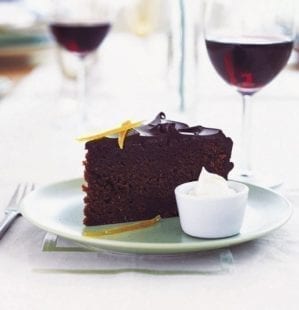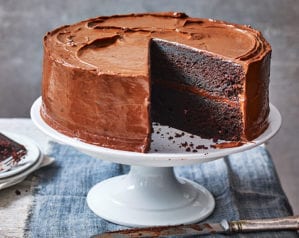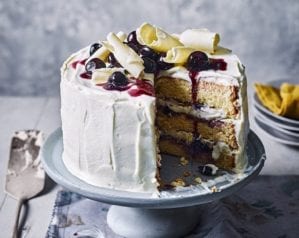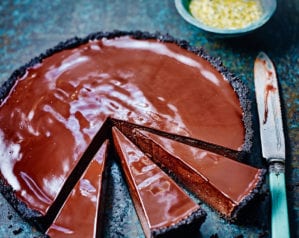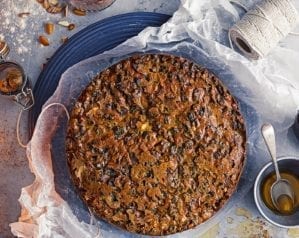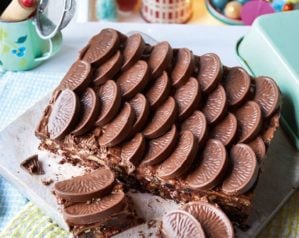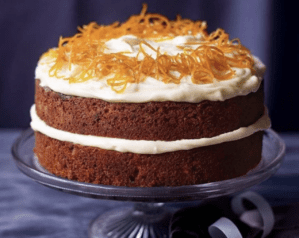
Chocolate orange blackout cake
- Published: 29 Oct 24
- Updated: 29 Oct 24
Not a fan of fruit cake, no matter how festive? How about a multi-tiered cream-filled chocolate orange cake instead? Star baker Edd Kimber loves a certain Quality Street choc so much he’s created it in cake form – and what a towering beauty it is. Give this blackout cake a go and it’ll become your regular bake every year.
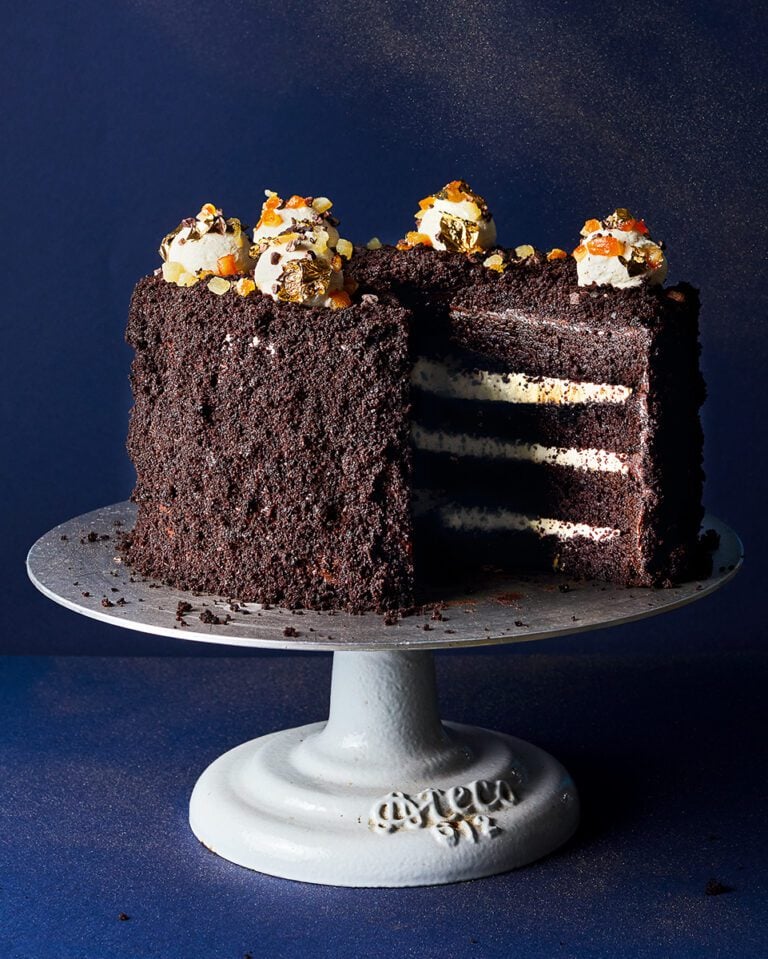
Edd says: “This rich chocolate cake is inspired by my favourite Christmas chocolate and a Brooklyn blackout cake, which traditionally sees chocolate sponges sandwiched together with a chocolate custard, decorated with ganache, then coated in cake crumbs. In this festive version I took inspiration from the orange cream found in Quality Street and made an orange mascarpone filling to use instead of the custard. ”
ABOUT THE AUTHOR Edd Kimber won the first ever Great British Bake Off way back in 2010 and has since written six bestselling cookbooks and makes regular appearances on TV, including on Sunday Brunch and Saturday Kitchen. Follow Edd on his blog theboywhobakes.co.uk or on Instagram @theboywhobakes
-
Serves 12-16
-
Hands-on time 1 hour, plus macerating (optional) and cooling. Oven time 35-40 min
Before you start
The cake can be baked a day or two in advance. Just leave the sponges in the tins and wrap to prevent them drying out. The fully assembled cake will keep in the fridge for up to 4 days.
Ingredients
- 125g unsalted butter, chopped, plus extra to grease
- 150g dark chocolate, finely chopped
- 385g plain flour
- 1½ tsp baking powder
- 3 tsp bicarbonate of soda
- ½ tsp fine salt
- 400g light brown soft sugar
- 75g cocoa powder
- 300ml strong black coffee, hot
- 335ml buttermilk
- 3 large eggs
For the ganache
- 200g dark chocolate, finely chopped
- 170ml double cream
- 2 tbsp golden syrup
- 160g unsalted butter, at room temperature
For the filling
- Finely grated zest 2 large oranges
- 3 tbsp caster sugar
- 250g mascarpone, chilled
- 200ml double cream, chilled
- 3 tbsp orange juice
To decorate (optional)
- 1 tbsp cacao nibs
- 2 tbsp candied mixed peel
- Gold leaf
Specialist kit
- 2 x 20cm deep round cake tins
- Piping bag
Method
- Heat the oven to 180°C/160°C fan/gas 4. Grease the cake tins with butter and line the bases with baking paper.
- Put the butter and chocolate in a bowl set over a pan of simmering water (make sure that the bowl isn’t touching the water) and leave to melt, stirring occasionally
- Meanwhile, sift the flour, baking powder, bicarb, salt, brown sugar and cocoa powder into a large bowl (see tips, below), then stir together to combine.
- Remove the melted chocolate mixture from the heat, then whisk in the hot coffee and buttermilk, followed by the eggs. Pour the liquid mixture into the dry ingredients, then stir together with a balloon whisk; just enough to form a smooth cake batter. Divide the batter equally between the cake tins, then bake for 35-40 minutes or until the cakes are starting to pull away from the sides of the tin and spring back to a light touch. Remove and set aside to cool for 20 minutes, then turn out onto a wire rack to cool completely.
- For the ganache (see tips), put the finely chopped chocolate in a large heatproof bowl. Add the cream, golden syrup and a large pinch of salt to a saucepan over a medium heat. Bring the cream mixture to a bare simmer, then pour it over the chocolate. Wait a few minutes, then stir to form a silky smooth ganache. Add the butter and stir slowly until the mixture is smooth. Set aside until the mixture has cooled and thickened to the texture of a soft, spreadable buttercream.
- Using a serrated knife, trim the domed tops off the cakes so they’re nice and level, then crumble the cut-off tops into a large bowl. Slice each of the cakes horizontally into 2 even layers so you have 4 sponges.
- For the filling, add the orange zest and sugar to a bowl, then rub together with your fingers until the mixture is fragrant and damp. If you can, leave this to sit for an hour or so and even more of the orange oils will be extracted, resulting in a punchier orange flavour. Add the chilled mascarpone and cream, then the orange juice. Whisk with an electric hand mixer until the cream holds soft peaks that flop over at the tip when the beaters are lifted out.
- To assemble the cake, put a disc of sponge on a cake stand or serving plate (or a turntable, if you have one, as this will make it easier to decorate). Reserve a little of the cream mixture for the top in a piping bag, then use an ice cream scoop or tablespoon to add a third of the remaining cream on top of the sponge. Smooth it out into an even layer, then put another cake disc on top. Repeat until you have 3 layers of cream, then put the final cake disc on top.
- Spread the ganache over the top and sides of the cake as evenly as you can, although don’t worry about how neat it is. Coat the entire cake in the crumbled-up cake scraps, then pipe the reserved cream in 6 neat blobs on top. You can decorate the cake however you like, but I like to sprinkle over some cacao nibs and candied peel, adding a little gold leaf for festive flair.
- Recipe from November 2024 Issue
Nutrition
- Calories
- 683kcals
- Fat
- 45g (28g saturated)
- Protein
- 8.9g
- Carbohydrates
- 58g (39g sugars)
- Fibre
- 5.1g
- Salt
- 0.5g
delicious. tips
BAKING KNOW-HOW
Smooth batter Good-quality brown sugar and cocoa powder are more prone to clumping, so make sure you give them a good sift. That way you won’t end up with lumps in your cake batter.
Boosting flavour Adding coffee to chocolate cakes, brownies, sauces and the rest boosts their chocolatey flavour. Coffee and cocoa are both rich in polyphenols, the natural compounds that give them their flavour. Mixed together, they interact to magnify the overall effect. Adding salt enhances the depth and complexity of the flavours even more, as it acts like a flavour enhancer on our taste buds. You mustn’t add too much salt though, as the molecules form strong bonds with flour proteins, firming up the gluten – not what you want in a soft cake.
Making ganache Don’t let the cream boil. If it’s too hot, it could overheat the fat in the chocolate, causing it to split. Chopping your chocolate finely means it will melt easily into the cream and create the required emulsion. Leave it for a few minutes so the cream cools down a bit before stirring – stirring too early could also cause the ganache to split. If your ganache does split, turning grainy and oily, you can revive it by whisking in hot (but not boiling, about 90-95°C) water, a teaspoon at a time, until it returns to a smooth, shiny ganache.
Buy ingredients online
Rate & review
Rate
Reviews
Subscribe to our magazine
Food stories, skills and tested recipes, straight to your door... Enjoy 5 issues for just £5 with our special introductory offer.
Subscribe
Unleash your inner chef
Looking for inspiration? Receive the latest recipes with our newsletter

